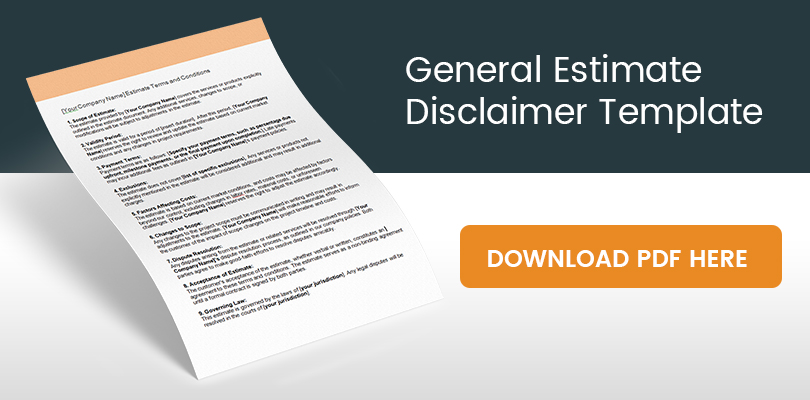- Introduction
Begin with a clear and concise introduction that explains the purpose of the disclaimer. For example: “This estimate disclaimer is provided to clarify the terms and conditions associated with the estimates provided by [Your Company Name].”
- Definition of Estimate
Define what an estimate is. Make it clear that an estimate is an approximation and not a guaranteed price. For instance: “an estimate is an approximate calculation of the likely cost, duration, or other relevant factors associated with a particular service or product.”
- Include Relevant Payment Data
Your estimate must include a price, general estimate terms, and some basic payment information. It’s significant to remember that your estimate’s pricing is “subject to change.” It will safeguard your small business from pricing changes. For instance, if you’re a small business owner and need to purchase lumber to finish a project, you have no control over the final price of lumber (which your estimate will consider). Additionally, you might want to note how any labor or price modifications will be billed. You can refer to such changes and fluctuating prices for direction if the task is more challenging than anticipated or the client’s requirements alter.
- Limitations of Estimates
Clearly state the limitations of the estimates. Mention that actual costs, timelines, or other factors may vary. For example: “Estimates provided by [Your Company Name] are based on available information at the time of estimation and are subject to change based on unforeseen circumstances or additional requirements.”
- Scope of Estimate
Specify the scope of the estimate. Clarify what is and isn’t included in the estimate. This helps set expectations for the customer. For instance: “This estimate covers [list of inclusions] and does not include [list of exclusions].”
- Factors Affecting Estimates
Outline the factors that can affect the accuracy of the estimate. This may include changes in market conditions, unforeseen challenges, or variations in project scope. For example: “Estimates may be affected by factors beyond our control, including but not limited to changes in market conditions, unforeseen challenges, or modifications to project specifications.”
- Communication of Changes
Explain how changes to the estimate will be communicated. This may involve notifying the customer promptly if there are any adjustments to the estimate. For instance: “In the event that the estimate needs to be adjusted, [Your Company Name] will communicate these changes to the customer as soon as possible.”
- Expiration of Estimates
Specify the validity period of the estimate. This could be a set number of days or weeks. Clarify that after the expiration date, the estimate may no longer be valid. For example: “This estimate is valid for a period of [insert duration]. After this period, [Your Company Name] reserves the right to review and adjust the estimate as necessary.”
- Dispute Resolution
Include a clause on dispute resolution. Outline the process that will be followed in the case of disagreements regarding the estimate. For instance: “Any disputes related to the estimate will be addressed through [Your Company Name]’s dispute resolution process as outlined in our [company policies/terms and conditions].”
- Legal Disclaimer
Conclude with a legal disclaimer stating that the estimate disclaimer is subject to the laws and regulations applicable in your jurisdiction.
- Review and Updates
State that the estimate disclaimer is subject to review and updates, and any changes will be communicated to customers. For example: “This estimate disclaimer is subject to periodic review, and [Your Company Name] reserves the right to update its terms. Any changes will be communicated to customers through [appropriate channels].”
- Additional details
- Company’s information:: Add your company’s information here to maintain a professional image and to provide contact information. For example, include details like your logo, address, phone number, email address, and other details you believe people might find valuable.
- Client info:: Make it obvious who the estimate is for in the client information. Include the company name, address, phone number, and email.
- Estimate number:: Similar to an invoice number, the estimated number makes it simple to track estimates and keeps you organized.
- Date:: This should be when you provide your client with the estimate, not when you first discussed the job.
- Project description:: The estimate should include a project description for the client to review. It aids in your ability to condense your understanding of the project and ensures that you and your client speak the same language.
- Terms and conditions: In your T&C, you might specify the client’s payment method and mention that estimates are subject to modification.
Even though there isn’t a formal contract between you and your client, you should always present yourself professionally. The details listed below should be present in a well-designed estimate template:
- Signature
As long as they are a part of a contract, disclaimers are legally binding. The contract must be written and include detailed descriptions of all terms and disclaimers. Most importantly, the estimate disclaimer should be duly signed by both parties, i.e., the contractor and the customer, to be considered a legally binding contract. Add an area where the customer and you, as the business owner, can sign and say both parties agree to the terms of the estimate disclaimer.









